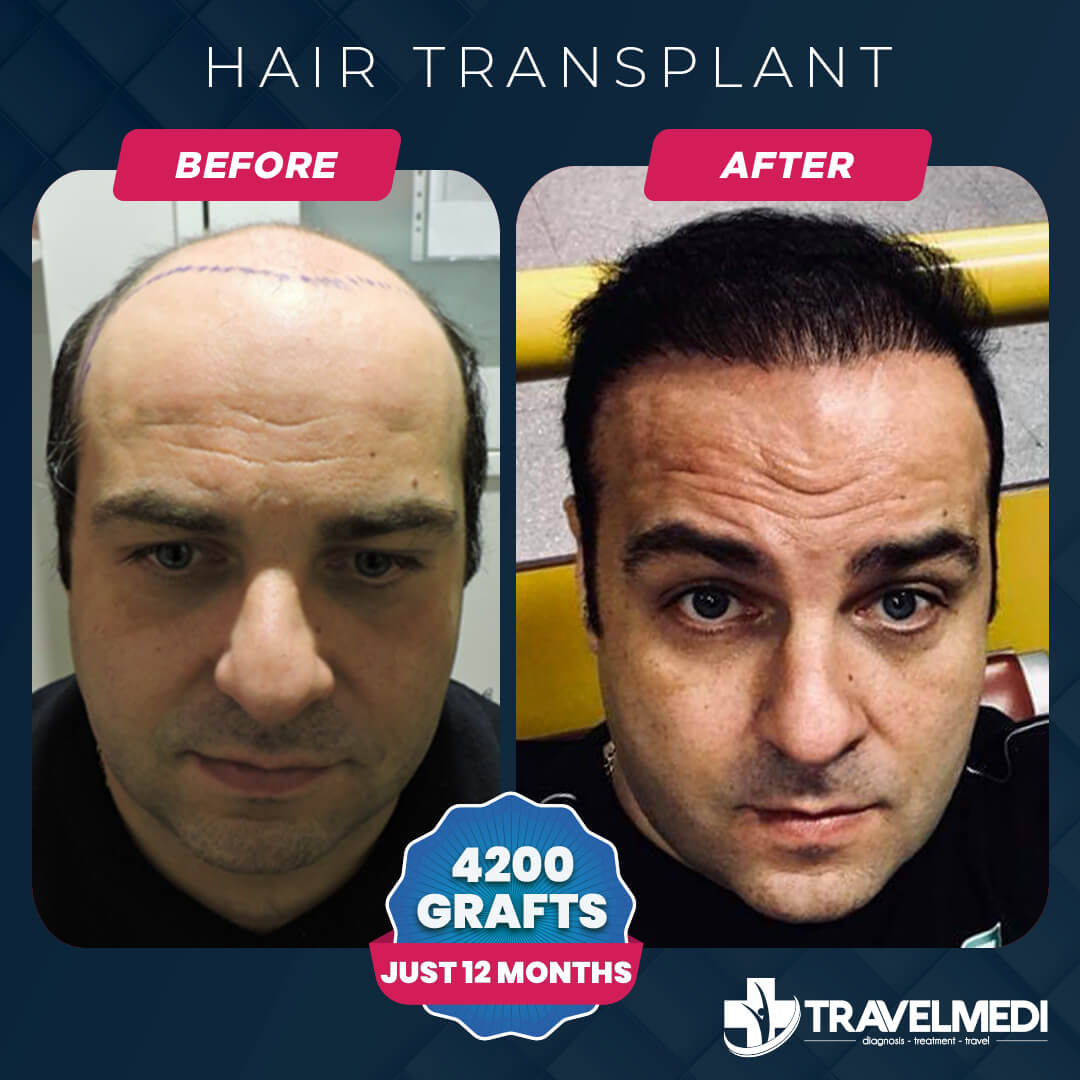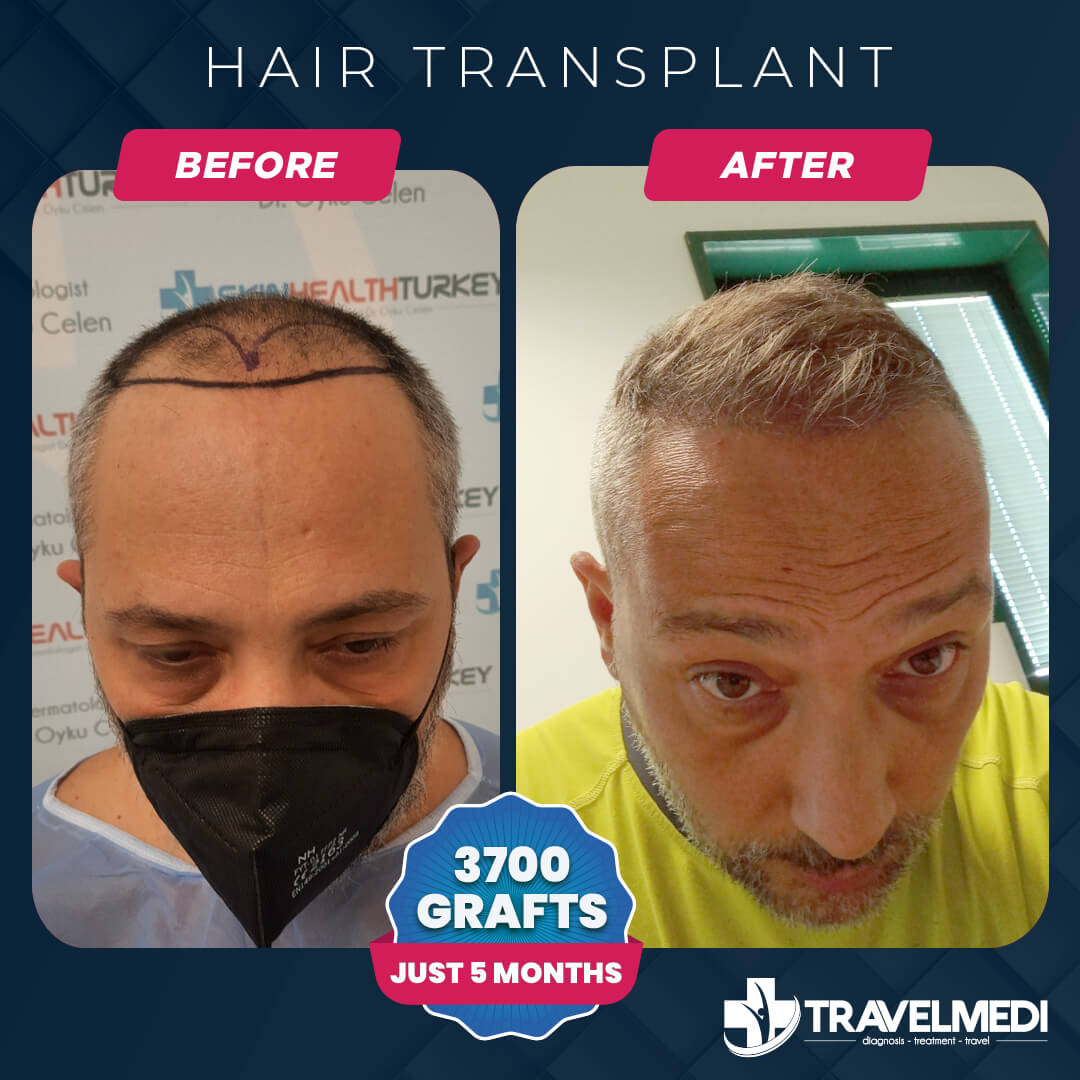
Hair Transplant General Overview
Anesthesia
Local
Duration of Intervention
4-8 Hours
Hospitalization
No Need
Definite Result
12-18 Months
Return to Social Life
2 Days
Return to Work
2 Days
Sports Activity Recovery
4 Weeks
Average Pain After 3 Days
0-1 *
*Pain rating scale: from 0 = absence to 5 maximum pain
Hair Transplant
The history of hair transplant starts back in 1800s. But the modern techniques were developed after 1930s. The first modern method is called FUT (Follicular Unit Transplantation) which consists of removing out a strip from the donor area and implanting the removed hair follicles back to the recipient area. After 1950s, hair transplant became a proper and accepted treatment thanks to Dermatologist Norman Orentreich’s studies.
Who can have a hair transplant?
Hair transplant is mostly preferred by men due to genetic coding which causes the hair loss. On the other hand even if women have different hormonal system, they can experience hair loss and can have hair transplant as well.
Besides, it is also possible to perform a hair transplant if the patient has a scar tissue due to an accident. In this case it turns into both aesthetical and medical treatment.
What are the causes of hair loss?
Genetics play the biggest role in hair loss; but with age, physical traumas or medical disorders hair loss can also occur. No matter what the cause is, if the patient has enough donor capacity, it is possible to perform hair transplant procedure. It can be performed not only for scalp, but also mustache, beard or any body part that hair is needed/desired.
How is hair transplant performed?
The main aim of hair transplant is to extract a certain amount of hair from the donor area, and implant them to the recipient area – where hair is needed. Once your hair is extracted to be transplanted, it is called “graft”.
Donor area is essentially the area on the back of your head – between two ears. However, if the back of your head does not have the sufficient density & capacity, it is also possible to extract chest hair, beard etc. We always prefer extracting from the back of the head, as they are much more resistent against hair loss. It is even possible to extract arm or leg hair, but not the ideal option as they are not as strong & think as others.
There are two methods of extraction of the hair follicles. The most modern one is called FUE (Follicular Unit Extraction) In this technique, follicular units are extracted individually by micromotor or manual punch devices. For more information please visit our “FUE” page.
The other extraction method is called FUT (Follicular Unit Transplantation) This method is rather old, and is not considered practical nowadays as it requires a strip of skin removal which creates a permanent scarring on the back of the head.
For the last few years, there have been new methods of “implantation”, however all these methods are a continuation of FUE method, as the follicles are implanted one by one.
- Percutaneous (Slit or Sapphire Blades): In order to implant the follicles, incisions (canals) need to be made with a blade. This blade can either be metal slits or sapphire blades Click here for more information about Sapphire FUE Hair Transplant
- DHI Method: In this method there is no pre-made incisions. Follicles are placed with an implanter pen. Click here for more information about DHI Hair Transplant
- Robotic Method: There are many developments for robotic hair transplantation but the most widely known is ARTAS brand devices. It is carried out under doctor’s supervision. The biggest disadvantage of this method is that it works very slow so it extracts a limited amount of grafts. It is quite pricey.
Besides all the methods that we have mentioned, all the others are generic ones and they have been put to the market as a marketing strategy.
What should I consider to choose a clinic?
The first thing to do is to find out if the clinic that you consult has a proper medical doctor or not. In order to avoid all the risks of complications, it should be performed in a well equipped clinic under supervision of doctor with an expert team.
In our clinic, all of the hair transplant procedures are carried out under supervision of our doctor in our clinic. The consultation and makes the planning of the procedure with the patient. While her expert team performs the surgery, she is present in the operation theatre and supervises each and every step to provide the best result possible.
Hair transplant is a surgical procedure. For this reason one should know that:
Hair transplantation should be carried out under supervision of a plastic surgeon or dermatologist.
There is not such specialty as “Hair Transplant Specialists” in Turkey, neither in any other country. Many clinics claim they have these “specialists” who are not even doctors in reality. These personel are either nurses, or people that do not have any medical background. For this reason, you should know the doctor well. Even if it is a procedure that only requires local anesthesia, only a doctor can know how to handle such possible complications. On the other hand, the ambient and equipment is also very important. It should be performed in a well equipped and sterilized operation rooms.
How is the process after a hair transplant?
It takes nearly 4 to 8 hours depending on the follicle amount that is transplanted. After the procedure your donor area is bandaged and you can return home or to your hotel.
The day after the procedure or two days after your bandage will be removed and a dressing will be made. Your first will be done and you will have a consultation about the instructions of how to wash your head during the first 10 days. This washing protocol can be explained shortly as follows:
You should apply the moisturizer lotion – which will be given to you – on your recipient area and wait for 45minutes to an hour. This lotion both softens the scabs and feeds the newly implanted grafts. Then you can rinse the lotion with warm water without pressure. After that it is time to apply the shampoo. This shampoo can be used for all the parts of your scalp. You should not rub, or massage the recipient area, but you should massage your donor area in order to clean it better. On your 10th wash, you should remove all the scabs from your recipient area, therefore you can start slowly rub it after your 7th was so they can gradually go. This regimen is very important, because if you have scabs for a longer time, they will block your hair roots and they will not successfully grow.
Between 1st and 3rd month, there will be a period which is called shock loss period. In this period 40%-70% of your implanted grafts will fall out, which is completely normal. On the 4th month your hair starts to grow and the density starts to come in slowly. Usually between 12th and 18th month you achieve the full result from your hair transplant procedure.
Table of Contents
- Hair Transplant
- Who can have a hair transplant?
- What are the causes of hair loss?
- How is hair transplant performed?
- What should I consider to choose a clinic?
- How is the process after a hair transplant?
- Hair Transplant Cost
- Hair Transplant Before-After Results
- Hair Transplant Reviews
- Hair Transplant Questions
- Does hair transplant cause any effect or loss of my native hair?
- What should I do before my hair transplant?
- Can I have completely unnoticeable and natural results?
- How many sessions should I get?
- How many grafts should be transplanted?
- When can I see my results after my hair transplant?
- Should I wait until all my hair is gone?
- Is it possible to transplant hair and beard at once?
- Can any scar be left in the donor area after the procedure?
- How should the frontal line be?
- What should I do after my hair transplant?
- What should I consider before getting a hair transplant quotation?

Patient Coordinator
Berat
Ask Now!
One of our patient coordinators will sincerely answer any questions you want to ask about Hair Transplant. Hair Transplant details, cost, reviews from other patients who performed Hair Transplant surgery in Turkey before and results. Do not hesitate to ask all you want to know about Hair Transplant surgery.
Hair Transplant Cost
Cost of Hair Transplant operation depending on various factors. Such as the hair transplant techniques (FUE, DHI), the experience of the doctor who will perform the Hair Transplant operation, and the hospital equipment. In the table below, you can see the comparison of the price of Hair Transplant operation between Turkey and other countries (USA, Canada, UK, Italy, Spain, Poland, Mexico).
| Country | Cost of Hair Transplant |
|---|---|
| Turkey | $1250 - $4000 |
| United States of America | $6000 - $10000 |
| United Kingdom | $5000 - $12000 |
| Czech Republic | $3500 - $6500 |
| Poland | $4500 - $7000 |
| Mexico | $3000 - $5500 |
| Italy | $5500 - $8500 |
As can be seen price comparison table Hair Transplant operation cost in Turkey starting from $1250 and it's 60% more economical comparing with the prices in USA, United Kingdom and Europe. The cost of hair transplantation in Turkey is lower than in the UK, USA and Europe, but the low operating costs does not mean that the quality of medical service is low quality. For this reason Hair Transplant one of most popular surgery in Turkey and nearly 40.000 Hair Transplant surgeries are performed in a year.
The main reasons why patients choose Turkey to have Hair Transplant surgery:
- All Inclusive Package Price: The most important criteria that people who want to have a Hair Transplant operation look for and want in terms of price is clarity. Turkey has a price advantage compared to Europe, America or UK with its quality treatment, accommodation, transfer services and all-inclusive price. As TravelMEDI, we would like to remind you that within the Hair Transplant treatment, treatment costs (such as surgeon fee, medication fee, equipment fees, hospital fee, test fee), accommodation fee, transfer fees between the hospital and the hotel or the airport and the hotel are included in the operation price.
- High Level Healthcare System: Turkey was one of the rare countries that did not experience a crisis in the health system even during the pandemic period, because it has large-scale and systematic health institutions (hospitals, number of experienced doctors, private clinics, well-equipped nurses and assistants). As TravelMEDI, we offer our patients the maximum health service at the most affordable prices in cooperation with experienced specialist doctors and highly equipped hospitals.
Hair Transplant Before-After Results
Some of those who has preferred TravelMEDI to have a new beginning to their life by having a Hair Transplant procedure in Istanbul, Turkey.
Hair Transplant Reviews
Reviews of our patients who prefer TravelMEDI for Hair Transplant operation around the world and their Hair Transplant experience.
Most Popular and Frequently Asked
Hair Transplant Questions
- Size of recipient area
- Capacity of donor area
- Quality and density of native hair














